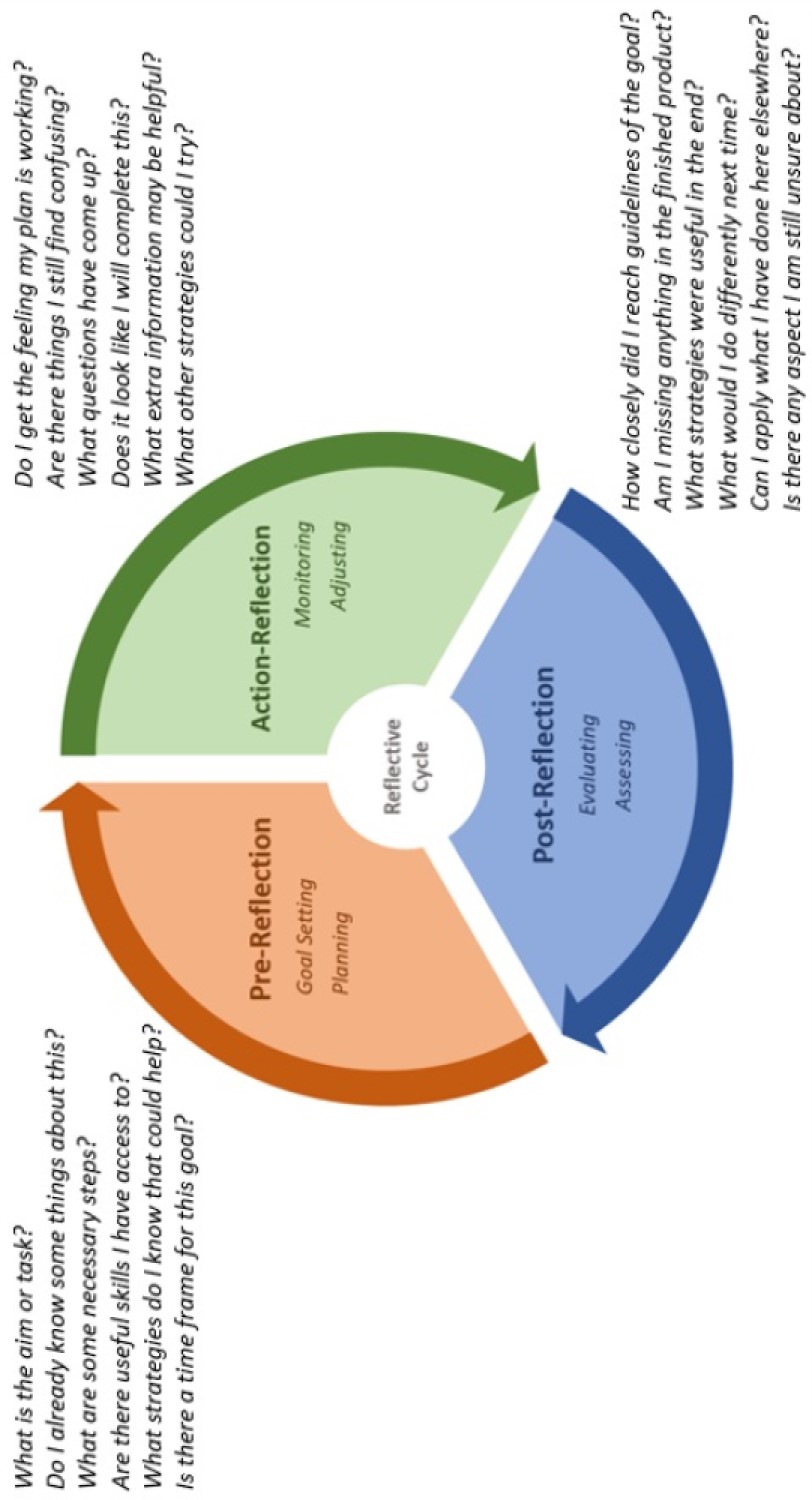5 How Do You Get Students Reflecting?
Expanding Our Idea of Reflecting
Sorry if you have skipped the Theory section to this point; but, before we look at what components are needed for students to reflect well, we must start by broadening our definition for reflection. Research into reflection or reflective practice often includes an acknowledgment that the common understanding of “reflecting” involves only retrospective thought.37,41 Even the popular Zimmerman SRL model, which alludes to monitoring throughout, specifically identifies self-reflection as the final phase (albeit of a cyclical process). Yet if reflection is used to continuously monitor processes within SRL, then the common understanding must be expanded. Thankfully, a systematic literature review—focusing on support of SRL in digital learning—identified and labeled three types of reflection used in research: reflection before action, reflection during action, reflection about action.18 Acknowledging the work of Schön, some researchers have even chosen to add directly to reflection-in-action and reflection-on-action, completing the continuum by identifying preparatory reflection as reflection-for-action.41
The Importance of Prompts
Nearly all studies on engaging reflection (to improve SRL, or otherwise) use some sort of prompt to direct participants. Students need support to be introspective and collect accurate data on themselves and their process. Poor learners tend to be reactive in their learning approach, applying strategies without forethought and rarely altering failing strategies in the moment. Prompt can be broadly defined as being questions, question stems, instructions, picture, or graphics used to provoke a response.40 In research however, most prompts used to support reflection are extensions of prompts suggested by Schön, who described reflective questions during his dissection of reflection-in action, by asking “What features do I notice when I recognize this thing?” and “What procedures am I enacting when I perform this skill?” Prompts should be used in digital learning for every step of the SRL process, such as: identifying the goal (What do I want to learn?), into planning and processing (How do I proceed?), and finally evaluation of the learning outcome (Did I reach the learning goal?).42 Helping students to use this approach to reflect continuously through the entire learning process is a strong instructional design strategy for educators using digital learning.18,24,43
The Reflective Cycle
Following our discussion on SRL models and the central role of reflection, the muddled terminology surrounding these ideas, and the recognition of the importance of continued reflection throughout the learning process, I decided to try my hand at creating my own graphic for this work. The graphic below was inspired by several authors, both in the interpretations of the SRL process,5,23 and in the use of prompts for continuous reflective practice.`1,30 I attempted to use clear, familiar language that students will easily connect with, allowing for quick internalization. The labels for each phase of the cycle are modified from Schön and reference reflecting on the task at hand: Pre-Reflection is reflection done before the task is started and involves identifying the goal and creating a plan; Action-Reflection is initiated during the task to monitor and adjust the progress and strategies; Post-Reflection is reflection at the conclusion of the task to evaluate and assess success. Each phase includes SRL-process indicators to help the student construct an overview of the learning component, and each phase is accompanied by six plain-language guiding prompts.

While it is possible to just take this graphic, show it to students, and start reflecting, I would caution you against thinking it will just be that easy. There is more to consider than just having a list of prompts and a sexy graphic! Building a robust and sustainable reflective practice in your classroom requires a consideration of how, when, and why these prompts are rolled out, as well as pre-emptively creating the scaffolding needed for students to find quality learning in the process. Students are often less than great at reflecting within the classroom and will need lots of support to improve this skill. But if you absolutely cannot contain your excitement and must start immediately, you could begin the conversation with these tips and work through the book as you go.
*Trumpower & Sarwar (2015), p. 188
Tips to Starting the Conversation
- Start today, this class!
- Build a group definition based on students’ current understanding of the word “reflection.”
- Brainstorm aspects of their lives where they currently reflect.
- Expand the definition of reflection and introduce The Reflective Cycle.
- Be open about your reflection experience personally, socially, and professionally.
- Discuss the differences between reflective work and descriptive work.
- Pick a prompt or an entry-level activity from the next chapter that can be scaled for any level of learner.
BOTTOM LINE


